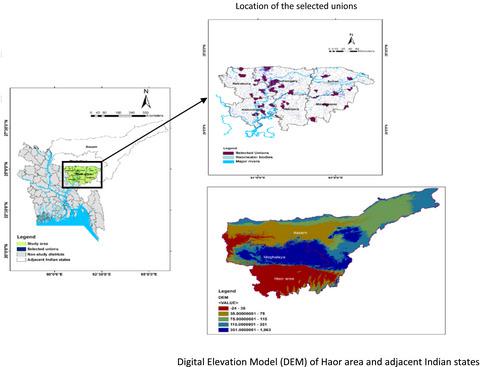当前位置:
X-MOL 学术
›
Food Energy Secur.
›
论文详情
Our official English website, www.x-mol.net, welcomes your feedback! (Note: you will need to create a separate account there.)
Household food insecurity after the early monsoon flash flood of 2017 among wetland (Haor) communities of northeastern Bangladesh: a cross-sectional study
Food and Energy Security ( IF 5 ) Pub Date : 2021-09-12 , DOI: 10.1002/fes3.326 Mahmood Parvez 1 , Mir Raihanul Islam 2 , Nepal C. Dey 1
Food and Energy Security ( IF 5 ) Pub Date : 2021-09-12 , DOI: 10.1002/fes3.326 Mahmood Parvez 1 , Mir Raihanul Islam 2 , Nepal C. Dey 1
Affiliation

|
The livelihoods of wetland (Haor) communities living in northeastern region of Bangladesh are largely dependent on agriculture. Unseasonably heavy rainfall in Haor basin and upstream Indian catchments triggered a devastating early monsoon flash flood in Haor basin at the beginning of April in 2017, which destroyed the nearly ready-to-harvest annual rice crop and resulted in significant income loss of Haor dwellers. The present study aims at assessing post-flood household food insecurity and the factors associated with it in the aftermath of this flash flood. A cross-sectional study design was adopted, and a survey covering 1845 flood-affected households was conducted to measure the post-flood household food insecurity. A set of questionnaires was adopted from Household Food Insecurity Access Scale (HFIAS) to assess the level of household food insecurity, and a modified poisson regression model was used to identify the risk factors of household food insecurity. A staggering 62% of the surveyed households were found food insecure following the flash flood. Being ultra-poor, loss of livestock in flood, household head's occupation being natural resource-based, and household reliance on market purchase of food were identified as significant risk factors of post-flood household food insecurity. Household being headed by relatively younger, educated people, and household owning agricultural land were found to be protective against post-flood food insecurity. Therefore, post-flood emergency programs, especially the food assistance programs should be designed prioritizing these most food insecure groups instead of considering household poverty as the only selection criteria. As a long-term plan, a multi-sectoral approach focusing on disaster risk reduction by taking into account the risk of disaster-induced food insecurity is essential to reduce the vulnerability of wetland communities.
中文翻译:

孟加拉国东北部湿地 (Haor) 社区 2017 年早期季风山洪后家庭粮食不安全:一项横断面研究
生活在孟加拉国东北部地区的湿地(Haor)社区的生计主要依赖于农业。2017 年 4 月初,豪尔盆地和上游印度流域的异常强降雨在豪尔盆地引发了一场毁灭性的早期季风山洪,摧毁了即将收割的一年生水稻作物,并导致豪尔居民的收入大幅减少。本研究旨在评估洪水后的家庭粮食不安全状况以及此次山洪爆发后的相关因素。采用横断面研究设计,对 1845 户受洪水影响的家庭进行了调查,以衡量洪水后家庭的粮食不安全状况。采用家庭粮食不安全访问量表(HFIAS)的一套问卷来评估家庭粮食不安全的水平,并使用改进的泊松回归模型来识别家庭粮食不安全的风险因素。在山洪暴发后,62% 的被调查家庭发现粮食不安全。极端贫困、洪水中牲畜损失、户主职业以自然资源为基础以及家庭依赖市场购买粮食被确定为洪水后家庭粮食不安全的重要风险因素。以相对年轻、受过教育的人为户主的家庭以及拥有农田的家庭被发现可以防止洪水后的粮食不安全。因此,洪水后的应急计划,尤其是粮食援助计划的设计应优先考虑这些粮食最不安全的群体,而不是将家庭贫困作为唯一的选择标准。作为一项长期计划,通过考虑到灾害引起的粮食不安全风险,采取多部门方法来减少灾害风险对于降低湿地社区的脆弱性至关重要。
更新日期:2021-09-12
中文翻译:

孟加拉国东北部湿地 (Haor) 社区 2017 年早期季风山洪后家庭粮食不安全:一项横断面研究
生活在孟加拉国东北部地区的湿地(Haor)社区的生计主要依赖于农业。2017 年 4 月初,豪尔盆地和上游印度流域的异常强降雨在豪尔盆地引发了一场毁灭性的早期季风山洪,摧毁了即将收割的一年生水稻作物,并导致豪尔居民的收入大幅减少。本研究旨在评估洪水后的家庭粮食不安全状况以及此次山洪爆发后的相关因素。采用横断面研究设计,对 1845 户受洪水影响的家庭进行了调查,以衡量洪水后家庭的粮食不安全状况。采用家庭粮食不安全访问量表(HFIAS)的一套问卷来评估家庭粮食不安全的水平,并使用改进的泊松回归模型来识别家庭粮食不安全的风险因素。在山洪暴发后,62% 的被调查家庭发现粮食不安全。极端贫困、洪水中牲畜损失、户主职业以自然资源为基础以及家庭依赖市场购买粮食被确定为洪水后家庭粮食不安全的重要风险因素。以相对年轻、受过教育的人为户主的家庭以及拥有农田的家庭被发现可以防止洪水后的粮食不安全。因此,洪水后的应急计划,尤其是粮食援助计划的设计应优先考虑这些粮食最不安全的群体,而不是将家庭贫困作为唯一的选择标准。作为一项长期计划,通过考虑到灾害引起的粮食不安全风险,采取多部门方法来减少灾害风险对于降低湿地社区的脆弱性至关重要。



























 京公网安备 11010802027423号
京公网安备 11010802027423号